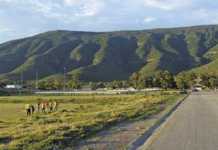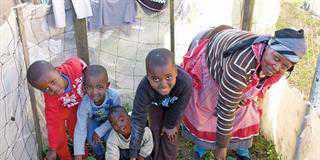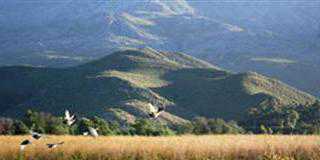It was a great place, where everyone knew everyone, where children were taught to swing cricket bats, tennis racquet and golf clubs by the nearest adult.
These were very much white spaces, however. Even in the late 1990s, almost two decades after independence, you could count the number of black members on one hand, and if they stayed on at the bar after a round of golf they generally sat together, ignored by the white members.
When the ‘land grabs’ began in 2000, the country clubs, given their association with white privilege, weren’t spared. Many were ‘occupied’, the facilities trashed, the hooch looted. Those that were left untouched soon found their membership dwindling as farming families fled the district. A lot were eventually left without any members at all – a true case of ‘will the last one out please switch off the lights’. Except by that stage electricity in rural Zimbabwe was near to non-existent anyway.
Norton Country Club
I returned to Norton Country Club in 2008 (http://mg.co.za/article/2008-12-23-i-had-a-farm-in-africa-young-mans-journey), and was surprised to find that the golf course was being well maintained. I soon learnt the entire property had been bought by a neighbouring piggery owned by a listed company called Colcom.
The sign outside now read ‘Norton Golf Resort. Preserving Nature, Preserving Rural Golf’. Aside from serving as a conference centre, it provided leisure options for the company’s dozen or so managers. In addition, there were two dozen black members, businessmen from nearby Norton mainly. And this, said one farm manager, helped to keep the piggery – and club – in the good books of the local political apparatchiks.
It was unsetting to see all the team pictures going back 90 years still on the walls, almost all of them featuring some or other relative, and to know that this way of life was over, gone forever. At the same time it seemed likely that there would be a constructive after-life for the club. I decided then it would be interesting to someday seek out the other clubs I had known or heard of, to see how they’d fared.
The Bulawayo Club
I managed to do this recently, driving up north with my talented photographer friend Lisa King (http://www.lisakingphotography.com/), who aims to publish a photo essay about Zim’s country clubs. Our first stop is the Bulawayo Club, a glorious colonial relic in the heart of Zimbabwe’s second largest city, and once notorious for its refusal to allow women into the main bar.
So it’s ironic the only person in the bar when we arrive is in fact a woman. Sharon Stead’s tourism business, Amalinda, took over management of the club in 2010, after it fell on hard times.
Another irony! It’s wicked to find humour in misfortune, but we can’t help chuckle when Sharon tells us that, while the club resisted war, a political revolution and women’s lib, it was undone by its members’ insistence that they be allowed to continue to run lengthy tabs at the bar, even with the value of the Zimbabwe currency halving on a daily basis, as it did in 2008. This, of course, left the club seriously out of pocket.
The place’s wonderfully anachronistic feel hasn’t suffered all that much from Amalinda’s management, although it’s undoubtedly more of a ‘presentation of the past’ than a case of the past continuing to live in the present, which was the case just a few years back. But then “better that,” as manager Rob Waters tells us, “than having the place become a glorified shebeen, which is where it was headed.”
Saunders Park Golf Club
Our next stop is the pretty montane town of Shurugwi, where we gawk at Saunders Park Golf Club from a blue scaffold. A 30m-deep hole is where the first fairway had once been. The course was always the property of Zimasco, a local mining company, explains our guide, “and although the white managers knew there was chrome beneath it, they loved the game too much to want to mine it. When they left, the company’s figures were low and the new manager saw no reason not to dig up the golf course.”
You can still see the clubhouse had once been a place of beauty, a humble building on high ground surrounded by giant Mopani trees. Rocks from the blasting have brought down the roof, though, and all that remain of whatever had once graced the interior is the sound board from an upright wall piano and – aptly – a mouldy old golf bag.
“This was once one of the country’s finest courses, but things change and nostalgia does nobody any good,” says our guide philosophically. Then, with a wink, he reminds us that Shurugwi “started as a rough mining town, and in some respects that’s where we are again – perhaps in 50 years people will be playing golf here again.”
Gwenoro Dam
A few kilometres outside Shurugwi is a place locals refer to as a ‘country club’, but unlike most of Zimbabwe’s country clubs the focus here was on bass fishing and sailing. The club stands on the shores of Gwenoro Dam, the clubhouse and chalets shut down years ago, and nobody goes sailing on the dam any more.
The security guard posted at the site by Zimasco, which owns this property too, explains that two groups of land beneficiaries have organised themselves into fishing co-operatives with the permission of the National Parks Authority. “At least the locals get the benefit now,” he says. But later we’re told the dam has practically been fished out.
Enterprise Country Club
Harare was once surrounded by vibrant agricultural communities and each had their country club, which used to compete strenuously for annual cups across several sporting codes. Trying to ascertain what’s going on at these clubs today isn’t easy, however, and so we were forced to cold call, often with alarming consequences.
One afternoon, for example, we drove north on Enterprise Road to find the Enterprise County Club, once the home club of Zimbabwe fast bowler (and chicken farmer) Eddo Brandes and much like the Norton Country Club in design. But when we arrived it was immediately clear that the fates of the two clubs had diverged sharply in recent years.
Where Norton Country Club has been preserved by hook or by crook, Enterprise has become the headquarters of the Goromonzi War Veteran’s Association. We ignorantly blundered in to a meeting of said war veterans, and although we strenuously denied that we were journalists, they decided to hold us hostage anyway while they waited for the local Central Intelligence Officer to come and question us.
We would have been oblivious to the fact that we were being ‘held’ (the men were being fairly pleasant to our faces) if it wasn’t for a whispered instruction from a good Samaritan: “Get out of here, however you can”.
And so we piled into the car, locked the doors and sped away with an old revolutionary running after us, cursing strongly.
Marondera Country Club
This country club, we were told, was in good health, a place with black and white members in similar numbers. But when we get there we see that, like most of Zimbabwe’s country clubs, the Marondera is now little more than a dingy bar in which the portraits of the former white chairmen have been removed, leaving dark rectangles of green felt. At the end of this line of ghosts remain the portraits of the black chairmen.
The golf course is in good nick, however, and our visit coincides with the end of a sponsored golf tournament, and the clubhouse is full of merry drinkers, black, white and Coloured. And the black members keep to themselves on one side of the bar, just as they had in Norton Country Club in the 1990s, while the whites and Coloureds sit together, muttering racial slurs sotto voce, just like the white members of Norton Country Club used to.
One old white member explains that “the black members prefer to drink on their own at the country club, and we keep the place running so that they’ll leave us alone here.”
One old black member explains that “there are some old members who will never change, but the younger white members have a totally different mindset, and they’re the ones that are part of the future of this town and this club, not their fathers.”
Interestingly, the young white members in question are mostly farmers who’ve struck tenure deals with new land beneficiaries in order to take advantage of a massive spike in demand for food in the area around Tete in Mozambique, on the other side of the nearby eastern highlands, where the largest coal mining companies in the world have descended with their billions.
Worth fighting for
Returning to South Africa, I pondered possible lessons. Perhaps the first observation to make is that the revival of club life in many parts of Zimbabwe country testifies to the human enjoyment of play, regardless of race, though true racial integration remains incomplete.
Another trend is that the country clubs that have been revived tend to be close to towns rather than in rural areas, which reflects the fact that the economy of Zimbabwe’s urban areas is firming up, whereas the rural economies remain largely inert.
Rural clubs that have survived, such as Norton Country Club (which has gone from strength to strength and is possibly now the most vibrant country club in the Zimbabwe) and Triangle Country Club in Masvingo Province, have enjoyed the financial support and political protection of big money – Colcom and Implats, in the case of Norton, and Tongaat Hullett in the case of Triangle.
All in all, a surprising number of clubs are still standing, and as dairy farmer and chairperson of the Beatrice Country Club, Stof Hawgood, told us: “They’re worth fighting for, not because anyone is under any illusions about white farmers returning to the districts, but because these are community assets and one day they will hopefully be recognised as such by the communities living around them, and if that means the cricket pitch gets turned into a soccer pitch, who cares, just so long as they aren’t used for the benefit of one person, or family.”













